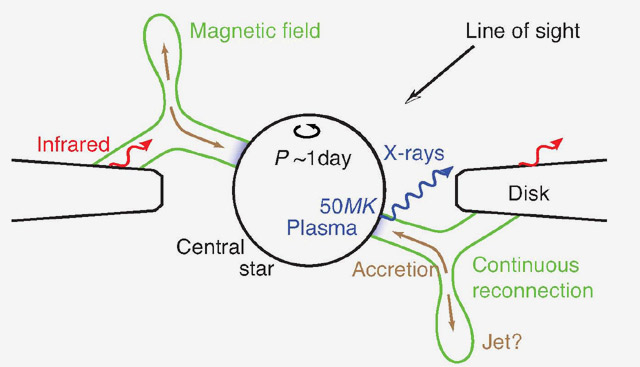An international team of astronomers combining data from the Japan-led Suzaku satellite, the ESA’s XMM-Newton and NASA’s Chandra X-ray Observatory has found something curious about a star that illuminates McNeil’s Nebula, a glowing jewel of cosmic dust in the Orion constellation.

The protostar V1647 Orionis resides at the tip of a conical glow called McNeil's Nebula, which was discovered in January 2004 near the peak of an outburst (Gemini Observatory)
The object, known as V1647 Orionis, is a protostar rotating once a day, or 30 times faster than the Sun. The stellar baby also has distinct birthmarks – two X-ray-emitting spots, where gas flows from a surrounding disk, fueling the infant star.
The young star first made news in early 2004, when it erupted and lit up McNeil’s Nebula, located 1,300 light years away in a region of active star formation within the constellation of Orion. The initial outburst ended in early 2006, but then V1647 Ori erupted again in 2008, and has since remained bright.
The astronomers combined 11 observations of V1647 to determine the source of the high-energy emission. They began monitoring the star shortly after its eruption in 2004 and continued to keep watch through 2010, a period covering both eruptions.
Strong similarities among X-ray light curves captured over this six-year period allowed the lead author of a paper published in the Astrophysical Journal (arXiv:1207.0570v1), Dr Kenji Hamaguchi, an astrophysicist at NASA’s Goddard Space Flight Center, to identify cyclic X-ray variations.
Dr Hamaguchi and the rest of the team determined the star is rotating once per day, making V1647 among the youngest stars whose spin has been determined using an X-ray-based technique.
“The observations give us a look inside the cradle at a very young star,” said co-author Prof Joel Kastner of the Rochester Institute of Technology. “It’s as though we’re able to see its beating heart. We’re actually able to watch it rotate. We caught the star at a point where it is rotating so fast as it gains material that it’s barely able to hold itself together. It’s rotating at near break-up speed.”
The team identified V1647 Ori as a protostar in formation. “Based on infrared studies, we suspect that this protostar is no more than a million years old, and probably much younger,” Dr Hamaguchi said.
V1647 Ori presently feeds on gas channeled from a surrounding disk and will likely continue to do so—though not nearly so rapidly—for millions of years. At that point it will finally be able to generate its own energy by fusing hydrogen into helium in its core like the Sun and other mature stars.
Dr Hamaguchi’s analysis focused on repetitive behavior found in the data from all three of the X-ray observatories. By combining data, he pieced together a picture showing the daily rotation of two X-ray-emitting spots on V1647 Ori that are thousands of times hotter than the rest of the star.
The hot spots are located at opposite sides of the star, with the southerly one five times brighter than its companion. Each spot is about the diameter of the Sun. In comparison, the low density of V1647 Ori bloats the star itself to nearly five times the size of the Sun.

Possible geometry of the V1647 Ori system (Hamaguchi K et al.)
“We think these spots are showing us X-ray-emitting regions that are very tightly constrained to a couple positions on the star by magnetic fields,” Prof Kastner said. “For six years, through two different eruptions, we’ve seen it rotate like this. That means the magnetic field configuration—the overall geometry between the disk and the star—is very stable. At the same time, the local disruption of magnetic fields probably generates the X-rays.”
“One attractive possibility for driving such high-speed matter involves magnetic fields that are undergoing a continual cycle of shearing and reconnection in mass accretion,” said co-author Prof David Weintraub of the Vanderbilt University.
_______
Bibliographic information: Hamaguchi K et al. 2012. X-raying the Beating Heart of a Newborn Star: Rotational Modulation of High-energy Radiation from V1647 Ori. ApJ 754, 32; doi:10.1088/0004-637X/754/1/32







